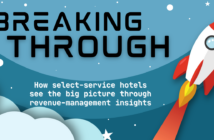Keep your best people and avoid an ocean of problems
The unpredictable market of 2021 hasn’t settled into anything resembling a groove during the fourth quarter. Labor, the biggest and most controllable expense for every hotel, is out of control, and high turnover rates are making the labor problem even worse. But, silver-lining alert, this is not a problem without a solution. Hotels are finding success at retaining and attracting good people through workplace culture-building efforts as one potential fix, and many also are turning to technology-based remedies.
For example, though employee turnover remains predictable, hotels can implement a sound labor-management solution, thus allowing them to improve employee retention and avoid the 30% extra cost they incur every time they replace a team member.
To address any problem, it must first be defined. Accordingly, the three keys to predicting turnover and preventing it are tenure, wages, and work hours. Tenure refers to the length of time an associate has been on the job. As it turns out, people tend to quit at predictable times, and this timetable has gotten shorter since the scramble to hire new people began in March 2021. For roles like housekeeping, new hires tend to be most likely to leave after three weeks, six weeks, and 12 weeks, the latter of which is the point at which they become fully productive.
Tenure isn’t the only indicator of retention risk, however. Wages are another key element to consider. Hotels need to monitor each associate’s compensation compared to their peers in the hotel and relative to the same job in the overall market. Today’s labor market moves very quickly, so managers need up-to-date, accurate information, obtained legally, to compare their associates’ wages and determine if there’s a risk. If an employee is being paid below-market wages or is underpaid relative to their coworkers, that’s a major indicator there’s significant turnover risk.
Work hours are the third predictor of turnover. From our data, we know that 30% of full-time eligible associates in the hotel industry aren’t getting 40 hours of paid work per week. With fewer hours, employees are earning less, making it impossible for even the most dedicated team members to stay onboard. Conversely, excessive work hours create burnout. While many hotel workers enjoy higher paychecks thanks to overtime shifts, the jobs are often physically demanding and tiring. If an associate has worked excessive hours for many weeks in a row, the possibility of turnover becomes high.
THE NUMBERS GAME
When these three factors align – associate tenure, relative wages, and work hours – a reliable technology solution can identify individual team members who are likely to quit before this happens. Good technology also can identify ways to avoid the risk and save the employee.
Here’s an example: Let’s say a new housekeeper on staff for three weeks has five “retention-risk” flags, including tardiness, taking too long to clean rooms, and has had conversations with management already. Meanwhile, another housekeeper has been on staff for one year but only has three flags. The data tells us there’s a much better chance the new housekeeper will quit.
“We work hard to find the best people and teach them to serve our guests according to our standards and expectations,” said Neel Shah, President of Hotel Evolution. “It’s devastating when they leave us, so we’re excited about cost-effective tools, which can prevent this from happening.”
Think about the expenses of replacing an associate. Based on adding 30% of the annualized cost of onboarding a new employee, let’s consider a housekeeper who makes $35,000 a year. If that housekeeper works 40 hours a week for 50 weeks a year, you’d add about $10,000 to replace that housekeeper. However, if you’re able to keep that housekeeper from quitting, you net $9,000 in savings for that position thanks to retention risk technology. That’s equivalent to about 90 revenue-producing room nights!
Hotel turnover has always been high, and this year, it has gotten demonstrably worse. Annualized turnover rates have doubled since pre-COVID. As of June 2021, housekeeping retention rates were trading at 163% a year vs. 109% in 2019. Hotels are replacing every housekeeping role 1.5 times this year, plus adding about $14,000 with the cost to that role. Guest-service roles also are hard to keep, with turnover up to 155% annualized in 2021 compared with 2019 attrition rates of 88% for this critical, guest-facing role. Assistant GM turnover rates also have soared to 103% annualized, compared with 35% pre-COVID.
Unfortunately, labor in our industry will remain a chief concern for the foreseeable future. As a result, many hotels are adopting labor-management systems to optimize their highest cost, improve productivity, and boost GOP margins. Investing in time-saving, automated, smart technology to manage labor issues might once have been viewed as an extra perk, but they are fast becoming a new baseline.





